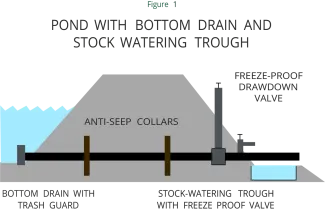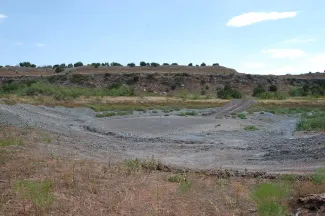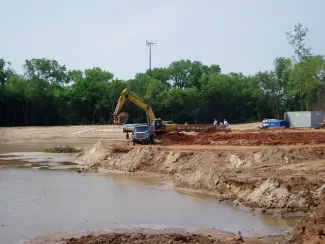
This section provides a general summary of pond construction tips. The best source of construction advice is your local NRCS. They will provide free expert assistance in planning and designing your pond. Additionally, they can tell you whether financial assistance is available to help with the cost of construction. The NRCS is an agency of the U.S. Department of Agriculture.
A successful fish pond requires a quality water supply. The water must not be contaminated with feedlot runoff, pesticides, herbicides, industrial waste, or excessive silt. Drainage areas completely covered with grasses or woody vegetation provided the best water source for fish ponds. Natural drainage ponds in Oklahoma should have from five acres (in eastern Oklahoma) to 20 acres (in western Oklahoma) of the drainage area for each surface acre of pond. Again, the NRCS can calculate the right size pond for your drainage area. A small yet adequate drainage area for fish ponds is best so that nutrients and fish are not washed out of the pond during periods of high runoff. If possible, select a site for your pond where a relatively low and short length of the dam will back water over a wide and flat area to get the most for your money. Generally, avoid damming creeks or large deep draws unless excessive water can be easily diverted. The resulting ponds are difficult to manage because fish and nutrients are consistently flushed from the pond and eventually unwanted fish enter and become established. Pick a pond site with clay or clay loam soils to reduce seepage. If adequate clay is not available at the site, then it will need to be hauled in to line the bottom and build the dam core.
From a fish management standpoint, the following are some of the main points you should consider in pond construction. A fishing pond should be at least a half surface acre and at least 10 feet deep in a quarter of its area to ensure adequate water during dry years. Smaller ponds can produce fine fishing, but they are susceptible to overharvest and require more intensive management.

A bottom drainpipe is a big plus in managing a pond; it will allow you to totally drain and reclaim the pond in the future if the fish population gets totally out of balance or if unwanted fish enter the pond. A drainpipe also allows for a partial drawdown to control shoreline vegetation, force stunted forage fish out of cover making them more vulnerable to predation, and facilitate repair of the dam or shoreline. A catfish pond where fish occasionally will be seine-harvested definitely needs a smooth bottom and bottom drain.
The pond dam should be at least 10 feet wide at the crest and have a 3:1 slope (three feet of width for every foot of height) on the front side and a 2:1 slope on the backside – see Figure. Do not allow trees to become established on the pond dam because tree roots can lead to seepage problems in later years.
The banks also should be steep, about 3:1 slope, to a depth of three to four feet to control rooted vegetation and increase shoreline fishing access. Have the bulldozer operator build an earthen fishing jetty or peninsula with the extra dirt removed when steepening the banks. This probably will become the most popular fishing spot on the whole pond, especially if a brush pile is placed within easy casting distance of the jetty.
Seed the pond basin area with a fast-growing crop such as rye or wheat to control erosion during filling. Minimize erosion around the pond by establishing good sod-forming grass, such as Bermuda grass, and by excluding cattle. This is the best way to prevent problems of turbidity (muddiness). A freeze-proof trough can be built into the back of the dam and fed from the bottom drain. Studies have shown that cattle have less hoof rot and other disease problems when not allowed to stand in water, plus you won’t have to worry about a cow or calf falling through ice and drowning. Another point to consider is that on freezing mornings you will no longer have to chop ice to provide water for cows. If cattle are present, your pond should be fenced to keep them away from the shoreline. If watering is mandatory, allow only a small area for access to the water to control the amount of erosion and shoreline damage from traffic.
Make the spillway as wide and flat as possible so that water going over the spillway during heavy rain will be very shallow and few fish will be lost downstream. An alternative, generally not recommended by NRCS engineers, is to screen the spillway. A well-maintained fish screen (one-inch square mesh) will prevent your fish from leaving and will keep unwanted fish from entering your pond. However, screens tend to clog with leaves and brush, backing water up over the dam and washing it out if not cleaned regularly. One solution to the leaf clogging problem is to build a horizontal bar barrier from round metal bars which are welded to vertical posts with at least one-inch vertical space between the bars. A fact sheet is listed in the Additional Information section, which describes spillway barriers for farm ponds.
All anglers know that fish are attracted to “structure”, and you may wish to provide this, especially if the bottom of your pond is smooth and featureless (see Figure 2). Habitat development for fish ponds can include spawning substrate, fish shelters, and fish attractors. Commonly available items that work well are gravel beds, concrete sewer tiles, wooden forklift pallets, cedar trees, brush piles, tire modules, and masonry blocks, or artificial fish structures. It is best to anchor items that can float, such as trees, so they don’t scatter around the pond and become lure hang-ups. Structures such as brush piles or tire modules can be built during pond construction. It is much easier to build these in a dry pond bottom than to add them later from a boat. Mark these structures with a GPS for accurate locations or a float or long, solid stick so you know exactly where to fish. Don’t put fish attractors in areas where water will be deeper than six feet because there may be no oxygen below that depth during the summer. Obviously, you do not want to install structures in a catfish pond that you intend to harvest by seining.
